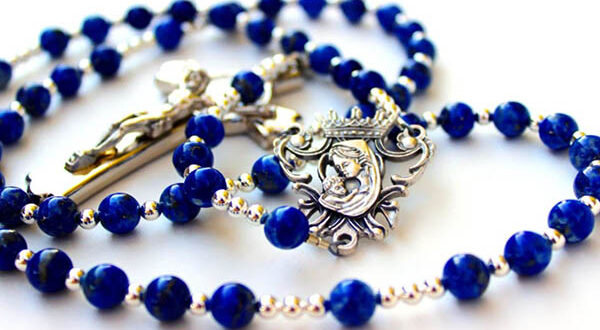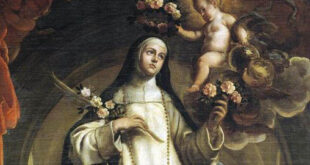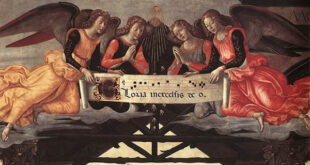A theological, historical, and pastoral look at the blue of Mary, Queen of Heaven
Introduction: What Can a Color Tell Us?
In the world around us, colors speak. Red shouts passion and martyrdom, white purity and light, green hope… but there is one color that not only speaks—it prays: Marian blue. Far from being a mere aesthetic choice, this color carries a history, a theological weight, and a spiritual strength that make it unique. In Catholic tradition, blue has been reserved — and rightly so — for the Mother of God. And not just any blue: a deep, almost heavenly blue linked to the pigment derived from lapis lazuli, a gemstone fit for queens. But why has the Church been so careful to reserve this color exclusively for Mary? What does this blue tell us about our faith, our history, and our own spiritual lives?
This article seeks to answer those questions. More than a lesson in art history, it is an invitation to gaze with new eyes upon the Virgin and to understand how color can be a doorway into the mystery of the Incarnation, the divine maternity, and our own call to holiness.
I. The Sacred Origins of Marian Blue: A Story Between Art and Liturgy
1. Lapis Lazuli: A Stone of Heaven
To understand Marian blue, we must first trace the origin of its pigment: lapis lazuli, a semi-precious stone of intense blue that, for centuries, was more valuable than gold. This mineral came mostly from the mines of Badakhshan, in present-day Afghanistan, and was brought to Europe through long and costly trade routes. Only the most skilled painters and the most important commissions could afford to use it.
In medieval and Renaissance sacred art, the use of lapis lazuli blue was not merely decorative—it was a declaration of faith, a sign of worship, a theological choice. For this reason, the Church reserved this blue to represent the Virgin Mary, the “woman clothed with the sun” (cf. Rev 12:1), whose dignity could only be expressed through the most precious materials in creation.
2. Its Evolution in Sacred Art
During the Middle Ages and the Renaissance, Mary appears clothed in blue in countless icons, frescoes, and altarpieces. From Byzantine Madonnas to Murillo’s Immaculate Conceptions, Marian blue became a visual code: where there is deep blue, there is the presence of the Mother of God. Even when other sacred figures are portrayed in similar shades, it’s never the same blue: Marian blue was darker, purer, more expensive.
It was a reserved visual language. Marian blue was not shared with anyone—not with the angels, not with the saints, not even with Christ in many representations (who often appears in red or purple, symbols of his divinity and sacrifice). This was not due to inferiority, but function: Mary is the doorway to the mystery, the threshold of heaven. Blue is heaven made color.
II. Theological Relevance: Blue as a Sign of Mary’s Unique Dignity
1. Queen of Heaven: The Mariology Behind the Color
Marian blue is not simply an artistic homage; it is a theological affirmation. In Catholic tradition, Mary is recognized as Theotokos — Mother of God — and as Queen of Heaven, a dignity not earned by merit, but by her unique union with Christ.
Saint John Paul II, in his encyclical Redemptoris Mater, emphasized how Mary has a “completely singular place in the economy of salvation” (RM, 9). She is at once creature and Mother of the Creator, daughter of her own Son, the woman in whom the longing of the Old Testament culminates and the fulfillment of the New begins. Blue, the color of the heavens, points to this transcendent and eschatological dimension of Mary: it shows her elevation above all creation as a sign of the final destiny of redeemed humanity.
In the Book of Revelation, the woman clothed with the sun, with the moon under her feet and a crown of twelve stars (Rev 12:1), has traditionally been interpreted as an image of Mary. Though the text does not mention blue, Marian iconography introduces it as a symbolic language: blue indicates her heavenly belonging, her immaculate purity, and her role as mediator between God and humanity.
2. Immaculate Conception and Blue: Perfect Purity
Blue also points to the Immaculate Conception. As defined by the dogma proclaimed by Blessed Pius IX in 1854, Mary was preserved from original sin “from the first moment of her conception” (Ineffabilis Deus). In this context, Marian blue becomes a symbol of total, unstained purity, untouched by sin.
It is no coincidence that in the 19th century, with the rise of devotion to the Immaculate Conception and Marian apparitions (such as Lourdes), the use of sky blue in Marian images became more prominent. Blue was no longer just a costly pigment; it had become a spiritual language of purity, humility, and majesty.
III. Pastoral Applications: What Does Marian Blue Teach Us Today?
1. Rediscovering the Sacred in the Everyday
We live in an age saturated with images, colors, and symbols stripped of meaning. Marian blue reminds us that signs can and must be pathways to God. In our daily lives, we can rediscover the sacred through beauty, through what points us to the eternal. What if we began to look at colors not just with our eyes, but with our souls?
Having a Marian image featuring the traditional blue at home can be a catechetical act: a visual catechesis that teaches children—and reminds adults—that Mary is not just a decorative figure, but a living spiritual presence, our Mother, Queen, and Advocate.
2. Dressing Ourselves in Blue with the Heart
Beyond pigment and aesthetics, Marian blue invites us to “clothe ourselves in Mary” spiritually. Saint Paul tells us, “Put on the Lord Jesus Christ” (Rom 13:14), and we could add: put on the spirit of Mary. Imitate her humility, her obedience, her trusting faith. Marian blue calls us to:
- Seek purity of heart, as Mary lived it.
- Trust God even in darkness, like in the Annunciation (Lk 1:38).
- Be channels of heaven on earth, as Mary was in giving birth to the Savior.
3. In Evangelization: A Language That Still Speaks
Today more than ever, the image of Mary remains a bridge for evangelization. In a culture that has lost stable references, the Virgin continues to touch hearts with her silent presence and blue mantle. From Latin America to the Philippines, from Africa to Eastern Europe, images of Mary in blue are more recognizable than any other Christian figure. Her blue requires no translation.
IV. A Sign for Troubled Times: Mary, Cloak of Hope
In times of crisis — whether family, personal, social, or ecclesial — Marian blue becomes a symbol of hope, like the sky after the storm. Mary’s mantle has been invoked for centuries as refuge, comfort, and shield. “Under your protection we take refuge, Holy Mother of God,” prays one of the Church’s oldest hymns.
Blue invites us to look upward, to raise our gaze from the dust of sin and confusion, to remember that we have a Mother in Heaven who never abandons us, who watches over us with tenderness and strength.
Conclusion: More Than a Color, A Path
Marian blue is not a relic of the past nor a mere artistic whim. It is a theological sign, a spiritual call, and a school of faith. Through this color, the Church has expressed for centuries the beauty and depth of the Marian mystery. In a world that trivializes the sacred, rediscovering Mary’s blue is rediscovering the possibility of living a faith that is incarnate, beautiful, dignified, and luminous.
May we, when we see an image of the Virgin clothed in her blue mantle, not merely see a figure from the past, but a present invitation to take shelter under her maternal love. May Marian blue clothe our souls in hope, faith, and the joy of knowing we are children of a Queen who never abandons her own.
“Mary treasured all these things and pondered them in her heart” (Lk 2:19).
May we, too, treasure in our hearts the deep mystery of her blue mantle and allow that open heaven to transform us from within.






